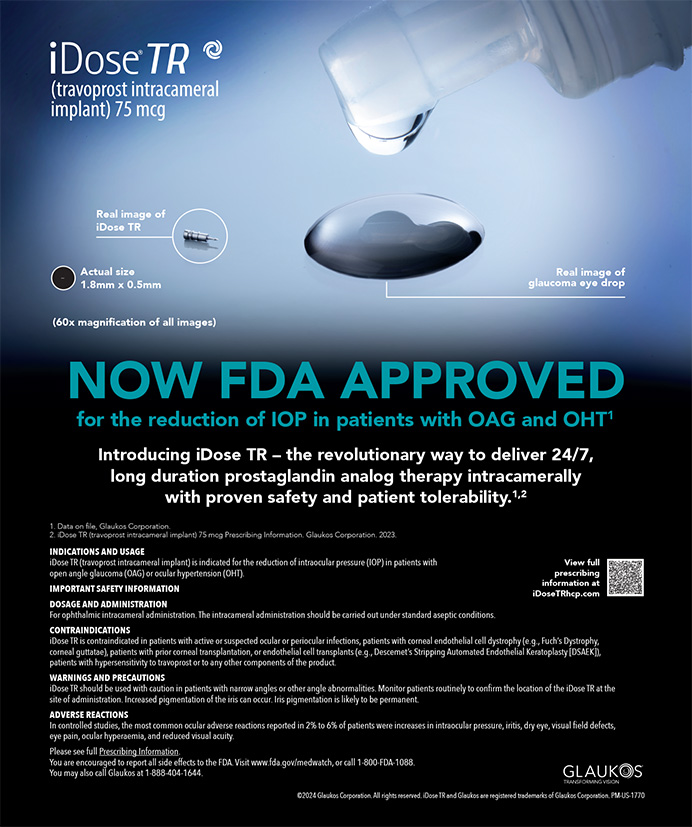The preservation of Bowman's membrane and the rapid visual rehabilitation associated with LASIK have made the procedure the first choice of many refractive surgeons and patients, but we must consider the potential for flap complications, which often affect the patient's quality of vision. In an effort to increase the safety and efficacy of these procedures, my colleagues and I conducted a retrospective study of 490 eyes (270 patients), comparing the various degrees of flap thickness, as well as the reproducibility of desired thicknesses, of four different types of microkeratomes. We included the Hansatome 180 head by Bausch & Lomb (San Dimas, CA), the Moria (Doylestown, PA) CB 130 head, the Moria M2 110 head, and the SKBM 160 head by Alcon Laboratories (Fort Worth, TX). Each procedure was performed using the LADARVision 4000 (Alcon Laboratories).
Forty-five of the surgeries were performed using the Hansatome, 65 were performed with the Moria CB, 256 with the Moria M2, and 127 with the SKBM. Using the subtraction technique, we evaluated each eye by making three measurements of central thickness both preoperatively and after the flap was lifted, recording the median value using a Cornea-Gage Plus 2 ultrasound pachymeter (Sonogage, Inc., Cleveland, OH). We then calculated the mean flap thickness and the standard deviation from the mean to evaluate the flap depth reproducibility for each microkeratome. Of the patients, 134 were males and 136 were female, with an average age of 43 ± 11 years (range: 19 to 67 years). The mean preoperative pachymetry was 547.6 ± 34.31 µm.
RESULTS
Procedures performed using the Hansatome yielded an average flap thickness of 131 ± 27.84 µm, which is two standard deviations thinner than indicated by the head sizing. Each of the Moria microkeratomes tested created a thicker mean flap than indicated by the sizing of the head; the M2 averaged 134 ± 23.45 µm, and the CB 157 ± 40.0 µm. At 162 ± 21.17 µm, Alcon's SKBM produced the thickest mean flap and also showed the lowest standard deviation. We also evaluated the consistency with which each microkeratome could reproduce anticipated flap thicknesses by comparing their standard deviations, which can be seen in the scatter graphs. The horizontal line corresponds to the sizing at the microkeratome head for each. Results with the Alcon SKBM and Moria M2 models were significantly more consistent than those of the Moria CB (P<.0005). We further observed that statistical variability was more prevalent in female patients than in males (P<.02). Also, flap thickness (FT) was correlated with preoperative corneal thickness (CT), but this occurrence was largely due to the indirect measurement error of the subtractive technique (FT = CT – stromal bed). Finally, in bilateral cases using each of the microkeratomes tested, the flap of the left eye was thinner than that of right eye (P<.0005).
EVALUATION
Given the current recommendation to leave at least 250 µm of residual corneal tissue, the ability to predict the actual flap thickness created during LASIK procedures significantly impacts the varying degrees of myopia that we can correct. We also found that thin flaps are more prone to the development of striae and are more difficult to manipulate without tearing.4,5 Cutting too deeply, however, may leave inadequate residual stroma for laser ablation and could compromise the structural integrity of the eye.4,5
The relatively poor level of predictability for the Moria CB may in part be the result of a stated change in the manufacturing process of the blades. It may also be due to the manual translation feature and subsequent lack of automation, which varies the speed of advancement and, consequently, the flap thickness. In each bilateral procedure, the surgeon operated first on the right eye and then on the left eye, and, in cases where the same blade was used for each, the flap of the left eye tended to be thinner. If the flap thickness of the right eye is less than 100 µm, the blade should be changed before making a flap in the left eye.
Our findings in this study coincide for the most part with the literature about these microkeratomes, which reports deviations of 120.8 ± 26.8 µm with the Hansatome in 140 eyes,6 155 ± 21 µm in 124 eyes using the Moria CB,7 and 161.1 ± 24.1 µm in 2,652 eyes with the SKBM.8 Flap thickness predictability can be a significant factor in minimizing flap striae and other complications associated with thin flaps, as well as those that result from thick flaps and compromise the threshold of residual stroma, such as ectasia. Based on our results, we can infer improved predictability in creating LASIK flaps using the Alcon SKBM and the Moria M2 microkeratomes, which have the lowest standard deviation of flap thickness. This predictability increases the safety when attempting to create thinner flaps (Moria M2), and thicker flaps (SKBM). Both of these microkeratomes use two motors: one for blade oscillation and the other for advancement. Our data indicate that the models using separate motors for these functions perform better than microkeratomes that power each function with only one motor (Hansatome), and those that have no motor at all to power advancement (Moria CB). Based on these findings, we have elected to use the Moria M2 when we wish to create a thinner flap, and the Alcon SKBM when a thicker flap is desired. We will also use the SKBM for corneas steeper than 47.0 D to eliminate the risk of potential buttonholes, as well as in post-RK corneas and in those requiring the creation of a second flap.
Ronald R. Krueger, MD, MSE, is the Medical Director of the Department of Refractive Surgery, Cole Eye Institute, Cleveland Clinic Foundation, in Cleveland, Ohio. Dr. Krueger may be reached at (216) 444-8158; Krueger@ccf.orgDanielle Mirandá Silva, MD, is in a PhD program at Federal University Sao Paulo, in Sao Paulo, Brazil. Dr. Silva may be reached at (5522) 55 725951; daniellemiranda@uol.com.br Material adapted from the poster presented by Drs. Krueger and Mirandá Silva at the ARVO meeting in May 2002.
1. Gimbel HV, Anderson Penno EE, van Westenbrugge JA, et al: Incidence and management of intraoperative and early postoperative complications in 100 consecutive laser in situ keratomileusis cases. Opthalmology 105:1839-1846, 1998
2. Gimbel H: Flap complications. Am J Ophthalmol 127: 202-24, 1999
3. Mannis MJ, Segal WA, Darlington JK: Making sense of refractive surgery in 2001: Why, when, for whom, and by whom? Mayo Clin Proc 76: 823-9, 2001
4. Walker MB, Wilson SE: Lower intraoperative flap complication rates with the Hansatome microkeratome compared to the ACS. J Refract Surg 16:79-82, 2000
5. Tham VB, Maloney RK: Microkeratome complications of LASIK. Ophthalmology 107: 920-924, 2000
6. Yildirim R, Aras C, Ozdamar A, et al: Reproducibility of corneal flap thickness in laser in situ keratomileusis using the Hansatome microkeratome. J Cataract Refract Surg 26: 1729-32, 2000
7. Salz JJ, Oyakawa RT, Ge J: Automated Hansatome Versus Manual Carriazo-Barraquer. ASCRS meeting, November, 2001
8. Flanagan GW, Binder PS: The precision of flap measurement for laser in situ keratomileusis (LASIK). J Refract Surg (in press)


